You can find more information about my board games at Board Game Geek (BGG): reviews, strategies, session reports and discussions. You can view my profile too.
In August 2006, a colleague of mine started to share his passion of board games with us. He organized weekly sessions, after lunch every Friday, that he'll introduce one or more games to us. I was skeptical at first. Sure, I like some board games, but I've never tried short games. To my surprise, the games he introduced to us — Take 6!, Saboteur, Poison, Bohnanza, among others — were very quick, fun and challenging! Since then, I've picked up some games on my own.
Our weekly sessions are still on! We have a regular group of about five players, sometimes as few as three and sometimes as many as ten! Our section manager was impressed by the games — and our spirit — that he authorized us to buy the games using the petty cash funds, but so far we have not taken up his offer.
What games do I like?
I prefer games that can be played with 2 players, but I usually prefer not to get purely 2-player games. I'm not very particular about the genre or theme of the game, but I like the mechanics to be different. As for game time, I'll prefer games that can be played in an hour or less. It'll be played much more often than longer games.
What games I don't like?
After playing many kinds of games, I realize there is one game mechanic that I dislike: games that allow the player order be changed as a result of a game action.
Examples:
- Agricola
- Caylus
- Citadels
- Manila
In such games, if you sit on the right of a player who likes to go first, then you'll always go last, unless you do something about it.
Some friends asked why Power Grid was not on the list. Well, in Power Grid, it can be strategic to either go first or last. Also, you can control the number of cities to connect and the power plants to buy.
Now that I think about it, my grief is not entirely with this game mechanic. I like how the player order is determined in Caylus. The first three spots can be chosen and the rest pushed down. This is a very fair way to determine player order.
Perhaps the game mechanic that I dislike is: games that allow the player to choose a set of actions from the board.
Examples:
- Agricola
- Caylus
- Manila
- Pillars of the Earth
And many others. In such games, player order is very important. I don't dislike all such games. Some games cross some threshold that make them unplayable for me. One such threshold is time. If it takes a long time to play, a bad play early on (before you realize the consequences) may mean you will never close the gap. The whole game session is not going to be very enjoyable.
Notes
Do I lend the games out?
There are many reasons why I hesitate to lend my games out. Some of the games are quite expensive, some are quite rare (at least locally) and some are out-of-print. It's difficult to tell how will the lender (and his friends) take care of the game. However, I also believe that if I lend games out, it's possible to gain new gamers.
The games I'm ready to lend out:
- Carcassonne
- For Sale
- Modern Art
- Take 5!
No questions will be asked upon their return as long as they are still in a playable condition. I can be persuaded to lend the rest of the games that are still in-print, but I'll check their condition upon return, and also that all the cards and bits are still present.
On sleeving cards
I don't like to sleeve cards, because it makes the cards hard to shuffle. I only consider sleeving cards that are held most or all the time. I won't consider sleeving cards that are only handled lightly. Even so, I prefer to buy a second set for "special occasions".
On holding cards
One thing I especially hate are players who bend their cards on their hand. They will not be invited back.
Articles
A short strategy guide for Race for the Galaxy.
Other games
Games that I have played that I do not own.
My board games
Note: pictures are not to scale.
| Acquire |
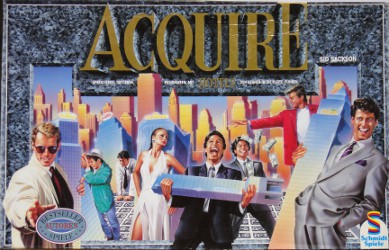 Release date: 1962
Release date: 1962
Mechanics: tile placement, hand management, stock holding, commodity speculation Players: 3 to 6 (2 with special rules) Playing time: 90 minutes Difficulty: easy Price: ? A game that has withstood the test of time. Despite being pretty simple, it has high replay value. In Acquire, you start new hotel chains, acquire smaller chains and get acquired by bigger chains. You can also buy shares for the hotel chains — the bigger the chain, the more the shares are worth. In the beginning, you generally want to start new hotel chains because you get one founder share for free. When the board starts to fill up, it's inevitable hotel chains start to merge. Generally, you want to get acquired in the middle of the game for three reasons:
Getting acquired is the only way to get more cash — you cannot sell your shares otherwise. Despite the name of the game, you want to get acquired, and not the other way round. I always forgot to get acquired and run out of cash. The first 2-3 medium-sized mergers are crucial. If you get left out, you'll never catch up. VersionsThis game has been released many times. The current version is a budget edition, so most people prefer the OOP 1999 Hasbro large-box edition. However, I decided to buy the 1993 German edition instead. It is even better, but is relatively hard to get in the US. I bought it from eBay Germany. |
| Carcassonne |
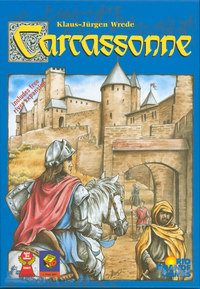 Release date: 2000
Release date: 2000
Mechanics: tile drafting, tile placement Players: 2 to 5 Playing time: 45 to 60 minutes Difficulty: easy Price: S$43 Carcassonne is a light game. The rules are very simple and plays under an hour. It makes a good introduction to German-style board games. Game PlayThere are 72 tiles. On each tile is a partial road, farmland or city. Starting with an initial tile, you draw a tile and place it on the existing map as long as the features match. You may choose to place a meeple (abstract representation of your people) on the feature, if there is no meeple on it. Once the feature is complete (road or city is closed), you score for that feature (if you have the most meeple on it) and take back your meeple. You only have 6 meeples, so you have to choose when to put your meeples. If you are not able to complete a feature, your meeple will be stuck there. Farms are scored only at the end of the game, so you will not be able to take back your meeple if it is placed on a farm. As you can see, the game is very simple: draw a tile, decide where to put it, then decide whether to put a meeple on it. You can play nice by completing your own features, or trying to find ways to merge features (most notably cities) so that you score for cities which other players are completing. The player with the most meeples on a completed feature scores for it. If two players have the same number of meeples, they score the same points. The only complicated part is the farm. From mid game onwards, you have to start placing meeples on farms. Each meeple you place is lost to you, and you are still not assured of scoring for it — the other players can fight for the same farm. Farm scoring can be confusing at first, so make sure you fully understand the rules before playing the game. Farms can make a huge difference to the final scores! To add to the confusion, there are two farm scoring methods: the first and third edition rules. WeaknessTile drafting depends on your luck. If you never get the tiles you want, tough luck. Some people like to play with one to three tiles on hand to reduce the luck factor, but I think it makes it too simple. There is a limited quantity for each tile, so you can easily prevent another player from completing a feature by placing difficult (or impossible) to match tiles next to it. The rarer tiles are very susceptible to this. This is likely to happen when there are few tiles left too. One option is to play with expansions, but that lengthens the game play. (One suggestion to shorten the game with expansions is to use a fixed number of tiles. However, this increases the possibility of incomplete features.) Roads are worth too little. The Inns & Cathedrals expansion solves this by making roads double or nothing when an inn is present. A completed Cloister is worth too little. Easily fixable. It should be worth 12 points instead of 9.
OthersCarcassonne comes with only 5 different colored meeples, that's why it is restricted to 5 players. You can play 6 or more if you get your own tokens. However, the randomness increases quickly for over 3 players. Carcassonne is quite unique in that it plays equally well as 2-player game. Conclusion[Sep 2006] I prefer to play just the basic set and with the first edition rules. I got these expansions as well:
|
| Citadels |
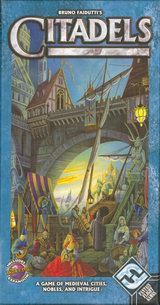 Release date: 2000
Release date: 2000
Mechanics: variable player power, card drafting Players: 2 to 7 Playing time: 60 minutes Difficulty: easy Price: S$35 [Jul 2007] I like it enough to buy it, although I'm still reserved on the variable player power part. WeaknessThe key strength and weakness of Citadels is the players' ability to affect each other. If you are the target of the Assassin or Thief for more than a couple of rounds, you're usually out of the game — there may be just 10 to 15 rounds. Do not choose obvious roles, or when you do, make sure no one will try to target you. I would prefer a variant that allows you to pay one gold to avoid losing your turn. The gold is put aside. The first person to decide to miss a turn gets all the accumulated gold. |
| Clue Master Detective |
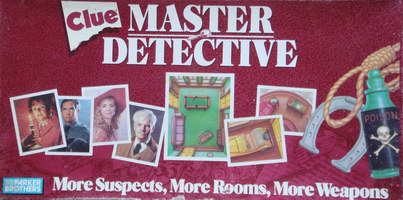 Release date: 1988
Release date: 1988
Mechanics: roll-n-move, deduction Players: 3 to 10 Playing time: 60 to 90 minutes (?) Difficulty: easy Price: OOP, US$20 to US$30 (used) Clue with four more suspects, two more weapons and five more rooms. The new elements and rules should be ignored and the original rules be used instead. Out of the OOP editions of Clue/Cluedo's, this is the most popular and yet is still affordable. [Sep 2006] Haven't played yet. |
| Cluedo |
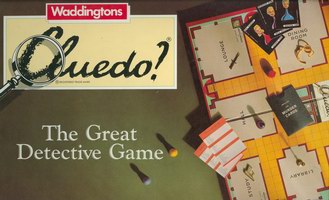 Release date: 1946
Release date: 1946
Mechanics: roll-n-move, deduction Players: 3 to 6 Playing time: 60 minutes Difficulty: easy Price: S$40 Be the first to find who, what, and where. Game Play6 suspects, 6 weapons and 9 rooms. Draw one from each category; that's your murderer, weapon and crime scene. Shuffle the rest and distribute them. Each turn, you can make a suggestion when you are in a room. A suggestion is the who, what and where (must be the same room you are in). If a player is able to refute your suggestion with one of his cards, he has to show you (and only you). When a player has deduced the solution by the process of elimination, he makes an accusation. If he is right, the game ends. If he is not, he is out of the game (since he has seen the solution), but he has to stay on to answer suggestions from other players. OthersSome people have suggested using the center of the board (the cellar) as a room to allow quick access to other parts of the board. WeaknessTakes too many turns to move into rooms. And players are moved whenever they are part of a suggestion, impeding their progress. Players who play too obviously (always using very similar suggestions) will reduce the deduction aspect of the game. Due to these two reasons, and also because there are more rooms than suspects and weapons, it often ends as a race for the rooms. Cluedo can be played without the roll-n-move mechanics, then it becomes a pure mental deductive game. Unfortunately, this makes the game much simpler because the most difficult aspect of the game — you need to be in a room to use it as part of your suggestion — is removed. Conclusion[1996] I like deduction games. |
| Cluedo (Nostalgia ed) |
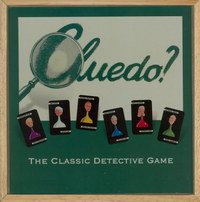 Release date: 2003
Release date: 2003
Mechanics: roll-n-move, deduction Players: 3 to 6 Playing time: 60 minutes Difficulty: easy Price: S$60, OOP This is the same as the standard edition, but in a nostalgic packaging. [Aug 2006] Got the game for its aesthetics and nostalgic look. I hesitated for a long time before deciding to get this. Unlike Clue, Cluedo did not change much over the years, so the contents are almost identical to the standard edition. I had to comb through several departmental stores to find it. The good news is, I was able to find it and it had been marked down to S$30. |
| Cluedo Super Sleuth |
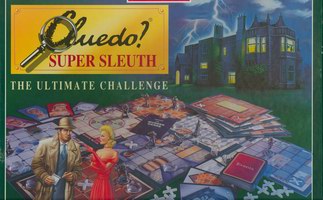 Release date: 1995
Release date: 1995
Mechanics: roll-n-move, deduction Players: 2 to 6 Playing time: 30 minutes (?) Difficulty: easy Price: OOP, US$10 to US$15 (used) Cluedo Super Sleuth is different from other Cluedo's that it can be played with 2 players. This game plays quite differently from other Clue's. When the game starts, you need to move around to collect the clue cards first. There are also item and event cards that increase your options. The rooms are revealed as you go into them (modular board). Another Clue variant that uses a totally different mechanic is Clue: The Great Museum Caper. [Sep 2006] Haven't played yet. |
| For Sale |
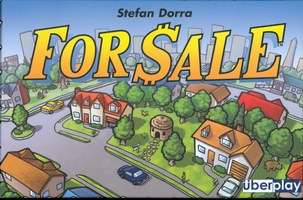 Release date: 1997
Release date: 1997
Mechanics: auction, simultaneous action Players: 3 to 6 Playing time: 15 to 20 minutes Difficulty: easy Price: S$27 For Sale is a fast and light auction game. Game Play(The following describes a 5-player game.) There are two phases. In the first phase, each player starts with $14k and bids for the properties numbered 1 to 30 (no repeat). 5 properties are revealed. If a player passes, he pays half his last bid amount (rounded up) to the bank and takes the lowest numbered property. The final remaining player pays his entire bid amount to the bank and takes the only property left (which is the highest numbered in that turn). He then starts the next auction. This continues until all properties are auctioned. In the second phase, the properties are sold in exchange for checks. There are 30 checks: 2 void checks and 2 checks each valued from $2k to $15k. 5 checks are revealed. Each player chooses a property to sell and puts it face down in front of him. When everyone has chosen, the properties are revealed. The highest property gets the highest check and so on. This continues until all the checks are used up. This phase is a kind of blind auction and plays similarly to Take 6!. At the end of the game, the sum of the checks and any remaining money are totaled up. He who has the most money wins. WeaknessThe luck factor can be quite high as it depends how the cards are dealt. One shortcoming of For Sale is that it cannot be played with 2 players. Conclusion[Oct 2006] Originally I did not want to get For Sale because it was very expensive for what was essentially 2 deck of cards. When playing, you seldom look at the art, just the numbers, so the theme is very thin. This applies to most card games, that's why I don't like to buy them. But in the end, it was far easier to get into the game with the pretty cards, so I still got it. |
| Fury of Dracula |
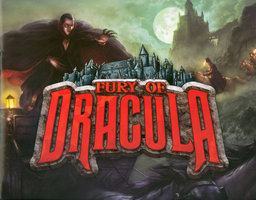 Release date: 2006 (original 1987)
Release date: 2006 (original 1987)
Mechanics: Co-operative, deduction Players: 2 to 5 Playing time: 120 minutes (?) Difficulty: medium Price: S$85 Plays like Scotland Yard, but with more rules, events and encounters. The 2006 version is quite different from the 1987 one. [Mar 2007] Unknown. Haven't played yet. I read through the rulesbook and there are many rules to remember! Also, many special cases are not covered. There is a rules update to make life more fair for the Dracula player. |
| Manila |
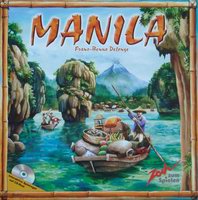 Release date: 2005
Release date: 2005
Mechanics: commodity and outcome speculation, auction, dice rolling Players: 3 to 5 Playing time: 40 to 60 minutes Difficulty: easy Price: S$70 Be the most successful smuggler in Manila! Game PlayThere are 4 kind of goods to transport but there are only 3 boats. The Harbour Master gets to choose which 3 goods to load — in addition to other privileges — so everyone bids to be the Harbour Master in a round-the-table auction (bid to stay in the auction until one is left). Next, the Harbour Master gets to place the starting positions of the boats. The boats need to move 13 spaces after 3 die rolls to make it to the harbour. The 3 boats can be placed at spaces 0 to 5 with one rule: the total must be exactly 9, so only 5-4-0, 5-3-1, 5-2-2, 4-4-1, 4-3-2 and 3-3-3 are valid. The Harbour Master also can decide whether he wants to purchase an additional share of the goods at the prevailing price, subjected to minimum of 5 pesos. Every player starts with 2 (hidden) shares and 30 pesos. The shares contributes to the final points based on their price. They can also be used to get loan at 12 pesos per share (regardless of the current share price), but they must be redeemed at 15 pesos (at any time). The voyage then starts. The Harbour Master gets to place his worker first. He can place it on the boats (being earlier is cheaper), the harbour, the repair bays, the pilot (influences the boat movement), the pirate or being the insurance agent. Then everyone plays their workers in clockwise order. For 3 players, there is an extra round of placing the workers before the first die roll. The boat has a payload, so if it made it into the harbour, the payload will be shared by all on board. It's not possible to put a worker on the boat once it has made it to the harbour, although some chose to play it this way. There are 3 harbour docks, with payoffs of their own. The first boat will make it to the first dock, so it has the least payoff, obviously. The repair bays are where the boats go if they don't make it to the harbour by the third dice roll. Like the docks, the first repair bay has the least payoff. If a player is confident no boat will make it to the repair bay, he can be the insurance agent and receive 10 pesos. However, he has to pay for all the repairs otherwise (either to the bank or other players). The pilots influences the boat movements. The small pilot can move one boat by +/-1, the big pilot by +/-2. The big pilot can choose to move one boat by +/-2 or two boats by +/-1. The pilots can move a boat into the harbour, but they may not move a boat out of the harbour. The pirate waits just outside the harbour at space 13. If a boat lands there on the second round, the pirate has the option to board it unless it is full. A variant is to still allow the pirate to board it by kicking off a worker. If a boat lands there on the third round, the pirate plunders it, meaning all workers are removed and he gets the entire payoff. There are spaces for 2 pirates. The second pirate moves after the first pirate. He can board or plunder the same boat as the first pirate, but he may not displace the first pirate in the case of boarding. Note that the pirates are resolved right after the die movement, so pilot movement do not trigger the pirates. The Harbour Master then rolls the 3 die and moves the boats accordingly. The round then ends and the next round begins with the Harbour Master placing his worker first. The voyage ends at the third die roll. Boats after space 13 have made it to the harbour. Boats in space 0 to 12 are placed in the repair bays. Boats in space 13 made it to the harbour if there are no pirates, otherwise the pirates plunder it and either direct it to the harbour or repair bay — this influences whether the price of the good goes up. Note that the harbour worker does not get the payoff for a pirate boat. All workers on the boats, harbour docks and repair bays get their payoff and the share price of the goods that made it to the harbour goes up by 5 pesos. The game ends when the price of one goods is 30 pesos. The next voyage starts with the bidding for the position of the Harbour Master, starting from the current Harbour Master. If everyone passes, he remains as the Harbour Master. OthersSome people disallow sure bets. Sure bets are when a boat has made it into the harbour and its dock is still empty (no worker). The starting share price is below zero. Thus, the share price will remain at zero for two successful voyages. Unredeemed shares do not count towards the points at the end of the game. However, they can be redeemed with the existing cash just before scoring. There is a blind passenger option: if a player is too poor to afford to place his workers anywhere, even after he has taken the maximum loan, he is allowed to place his workers on the boats for free. This usually doesn't help matters much, because if he's in such a bad shape, he's out of the game anyway. I believe this rule is to make the game more family-friendly. WeaknessThere are many rules and exceptions for a supposedly simple game. They exist to make the game more balanced. The dice rolling makes the game too random, especially in turn one. Hence, turn one bets are usually very conservative and predictable. For example, it's usual for one boat to reach the harbour and another one to reach the repair bay. It is essential to be the harbour master a few times. If you end up too poor to bid to be one, you're essentially out of the game. If the player to your left is very aggressive and always bids to be the Harbour Master, you are in the least favourable position cos you're going last for the entire voyage. A variant could be to make it more expensive to be harbour master consecutively. ConclusionManila is a very nice and simple game for beginners. They will like it due to the randomness factor. Plus, the artwork is very beautiful! However, it'll take a while to explain the game as there are many steps and possible actions. This will put off players new to board games. [May 2007] The name puts me off, that's why I never even considered it. However, after trying it once, I liked it so much that I bought it the next day! The commodity speculation reminds me of Modern Art. However, the luck element is too high to treat the speculation seriously. |
| Modern Art |
 Release date: 1992
Release date: 1992
Mechanics: auction, commodity speculation Players: 3 to 5 Playing time: 45 to 60 minutes Difficulty: medium Price: S$47 Be an art dealer and buy and sell art over four seasons. Game Play(The following describes a 3-player game.) There are 5 artists and 12 to 15 art pieces per artist. Each player starts with 10 art pieces. Each player has to sell an art piece via an auction in his turn; he is allowed to bid as well. Each art piece has a marking to denote the auction to use: open bidding, once round, sealed, fixed price and double. In open bidding, the highest bidder wins. In once round, each player either passes or bid only once (in clockwise order); the seller bids last. In sealed, everyone simultaneously reveals their bid (which may be zero). In fixed price, the seller names a price and the first player (in clockwise order) to accept gets it. In double, two arts are auctioned at the same time. The winner pays the seller and keeps the art piece in front of him. If the seller wins, he pays the bank. If no one wants the art piece, the seller gets it for free, except for fixed price auction. The season ends when the fifth art piece from the same artist is out. The art pieces are then ranked. The art pieces from the most popular artist are worth $30k each, the second most popular $20k, the third most popular $10k and the other two are worthless. The players sell their art pieces to the bank. Each player gets 6 more cards and the next season begins. The game plays exactly the same, except that during scoring, the worth of the art piece is cumulative of the first season — but only for the top three in this season. The other two are worthless in this season. Play this for two more seasons, and the winner is the one with the most money. WeaknessIt is very easy to get into analysis-paralysis in this game. The quality of the current Mayfair Games edition is so-so only, so I consider it overpriced. OthersThe English rules for double auctions says the proceeds are split if a player comes up with the just first double art piece and lets another player match it. The German one says the eventual auctioneer keeps the entire proceeds. I like the German one better. Although Modern Art needs at least 3 players, there is a 2 player variant that works quite well. It plays a little differently because it is a zero-sum game. Conclusion[Oct 2006] I got the German edition as well. It is of much better quality, but you need to buy it on eBay, so it's much more expensive as well. I got mine from eBay Germany. |
| Monopoly (Nostalgia ed) |
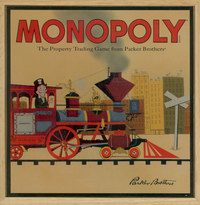 Release date: 2001
Release date: 2001
Mechanics: roll-n-move, trading, set collection Players: 2 to 6 Playing time: 90 to 120 minutes Difficulty: easy Price: S$60, OOP Everyone knows how to play Monopoly, including you. Or do you? Try reading the rules book and playing with the official rules. It becomes a much faster and tighter game. Some common unknowns and misconceptions:
WeaknessEven when playing with the right rules, the luck factor is still very high. You may be astonished, but Monopoly is a trading game. If you don't trade properties to form monopolies, you'll never finish the game. Conclusion[Aug 2005] Got the game for its aesthetics and nostalgic look. |
| Monopoly Deal Card Game |
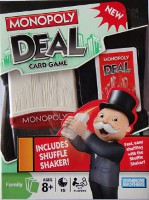 Release date: 2008
Release date: 2008
Mechanics: set collection, hand management Players: 2 to 5 Playing time: 15 minutes Difficulty: easy Price: ? [Aug 2008?] Got this as a birthday present from my brother. |
| Pandemic |
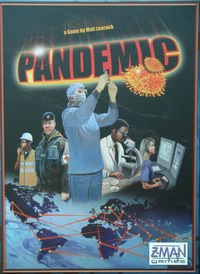 Release date: 2008
Release date: 2008
Mechanics: cooperative, hand management, variable player power, set collection Players: 1 to 5 Playing time: 45 to 60 minutes Difficulty: easy Price: S$50 In Pandemic, players are racing against time to cure diseases. [Jan 2009] Bought after a few plays. I liked the game the first time I played it, but it felt too light compared to Shadows over Camelot. Also, Pandemic is more like puzzle-solving than a real game, especially without the traitor element. However, I still decided to get it because it plays faster, is easier for beginners and has an easy theme to relate to. |
| Power Grid |
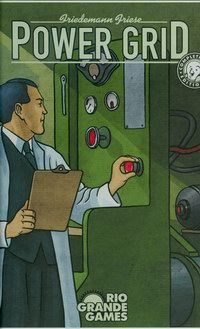 Release date: 2004
Release date: 2004
Mechanics: auction, resource management, area control Players: 2 to 6 Playing time: 120 minutes Difficulty: medium Price: S$78 Power Grid is, at its heart, a resource management and area control game, with minor element of auction. Players are power companies out to dominate the market. The game ends when the first player connects to the 17th city (in a four player game), and the player who can power the most cities wins. Game PlayThere are four basic elements: power plants numbered from 3 to 50, four resources that are used to power the plants, cities with connection costs and money to do everything. Power Grid is one hell of a bureaucratic game. A complete round has 6 phases; determine turn order, bid for power plants, buy resources, connect cities, power cities and finally replenish resources. The turn order is determined by the number of cities and then the power plant number. Turn order does not imply whether a player is ahead. All it means is he gets to bid for a power plant first and gets to buy resources and connects to cities last. 4 power plants are put up for auction. Another 4 are put up as preview. There are always 8 cards and they are always sorted in ascending order. The initial 8 plants are numbered 3 to 10. Plant 13 is always the first plant to be revealed, the rest are random. 4 plants are removed randomly at the start of the game. The player with the highest turn order goes first. He bids by selecting a plant; he has to pay at least the power plant number. If everyone passes, it's his. If other players are interested, it's a free-for-all auction. If the player passes, he may not participate in this phase anymore. When done, the player with the highest turn order and has not gotten a plant goes next. It could be the same player if he lost in the previous auction. If everyone passes this phase, the lowest numbered power plant is removed immediately. A player can only have 3 power plants, so if he already has three, he has to discard one of them. In the first turn, every player has to get a power plant and the player order is re-determined after the auction phase. Next, it is necessary to buy resources to power the plants. There are four resources: coal, oil, garbage and uranium. Coal starts at $1, oil at $3, garbage at $7 and uranium at $14. There are 3 units of each resource at each price point from $1 to $8. Uranium has only one unit per price point and goes to $10, $12, $14 and $16. The player with the lowest turn order goes first, so he'll get resources at a cheaper price. A player can only buy the resources that he is able to use. He can buy twice as many as the power plant needs. There are hybrid plants that can use either coal or oil. There are ecological power plants that do not use resources at all. Next is connecting to cities. Cities are connected by pipes and are grouped by regions. There are seven cities in each region and only four regions are used. The player pays $10 to connect to his first city. For subsequent cities, he must pay connection charges in addition to the $10. He must link any new connections to his existing network; he can skip cities if he want. Only one player is allowed per city, at least in "Step 1". Step 1 ends in the next phase when a player connects to his seventh city. In Step 2, each city can hold two players, but the second player pays $15. A player can connect one or more cities in his turn. If a player has the same or more cities as the number on the power plants on auction/preview, those plants are removed immediately. The next phase is powering the cities. A player decides how many cities he wants to power and removes the used resources from his power plants. He then receives money based on a payout chart. The last phase is to put aside (not discard) the highest power plant and replenish the resources. Each Step has a different replenish rate. If resources are used faster than they are replaced, they get more expensive over time and may even run out. The cycle then repeats. If at any point there are no more power plants to draw, the game enters Step 3. The plants that are put aside are shuffled and use as the new draw deck. In Step 3, there are 6 power plants in the market. Each city can hold 3 players, the third paying $20. And, the smallest power plant is removed in phase 6. There are many small things to remember. But it's not as bad as it sounds. As long as one player is familiar with the rules and details, he can make sure all the housekeeping stuff are handled properly. OthersMost people don't think Power Grid is enjoyable as a 2 player game, but I enjoy it very much. Mistakes are very unforgiving. Common mistakes:
WeaknessThere are two mid-game stalls that can really drag the game:
It's real tough to remember all the housekeeping things to do at each point. If I didn't forget one thing, it's the other. Most are near miss or are minor mistakes, but some can ruin a game. Power Grid is fiddly, but elegant. The only real downside is the length of a game — two hours; sometimes longer as the game is prone to analysis-paralysis. VariantIf no one buys a power plant, the lowest one is discarded, and $5 is placed on the power plants in the current market. Conclusion[Sep 2006] I already knew I would like Power Grid when I read about its mechanics. I got these expansions as well:
|
| Ra |
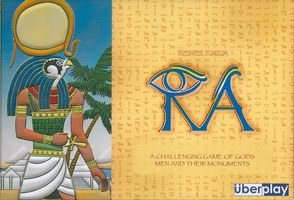 Release date: 1999
Release date: 1999
Mechanics: tile drafting, auction, set collection Players: 3 to 5 Playing time: 45 to 60 minutes Difficulty: medium Price: S$60 When I play Ra, I don't think of the pasted on theme. The mechanics overshadows it because it is extremely elegant. Ra is all about set collection. You bid for the tiles you are interested via once round auctions. Game Play(The following describes a 5 player game.) Each player starts with 3 "Suns". They are numbered 1 to 16, no repeats. The starting set is pre-defined. The smallest Sun, numbered 1, is put on the board. The game is played over three rounds (called Epoch). Each Epoch has at least 9 turns. There are two tracks on the board: an auction track and a "Ra" track. Each turn, a player can either draw a tile, call for auction (by saying "Ra") or take a tile from the tile track (if he has the God tiles that allows him to do so). Ra tiles are put on the Ra track and an involuntary auction is started. Otherwise the tile is put on the auction track and it's the next player's turn. When the auction track is filled up with 7 tiles, an involuntary auction is started too. When an auction is started, the player to the left of the auctioneer bids first. The auctioneer bids last. Each player either pass or use one — and only one — Sun to bid. The winner is the one with the highest Sun. He gets all the tiles on the auction track and swaps his Sun with the one on the board; his Sun becomes part of the next auction. The Sun tile is put face down; it cannot be used in that Epoch. If a player calls for auction and everyone passes, he has to bid. If everyone passes on an involuntary auction, the play continues; the auction track is not discarded. If the auction track is full and no one bids in that auction, the tiles are discarded. A player is out of the Epoch when he used up all his Suns. He does not draw any more tiles or play God tiles. If only one player is left with unused Suns, he can draw as many tiles as he likes, as long as all conditions for auction and Ra tracks are fulfilled. The Epoch ends when the tenth Ra tile comes out and scoring is done based on the tiles. There are 8 kind of tiles: gold, God, nile, flood, civilization, Pharaohs and monuments. Gold tile is three points. God tile is two points; it is more often used to take a tile from the auction track instead. Nile and flood tiles are one point each, provided the player has at least one flood tile. There are 5 kind of civilization tiles; the player gets -5 points for no civilization, 5 points for 3 different civilizations, 10 for 4 civilizations, 15 for all 5. The player with the most Pharaohs get 5 points, the fewest -2 points. Monuments are scored only on the third Epoch. There are also disaster tiles: 2 each destroying Pharaoh, nile/flood, civilization and monument. The disaster tiles take effect immediately after taking them from the auction track. After scoring, the gold, God, civilization and flood tiles are discarded. The players then turn over their Suns and the next Epoch begins. The play and scoring are exactly the same. Play again for the third Epoch and do the final scoring. There is additional scoring in the third Epoch: sum of Suns (highest +5, lowest -5) and monuments. There are 8 kind of monuments; one point for each different monument up to 6, 10 points for 7 different monuments, and 15 for all 8. In addition, 3 of the same monument gets 5 points, 4 of the same gets 10 points, 5 of the same gets 15 points. If scores are tied, then look at the sum of the Suns. If tie again, the player with the highest Sun wins. OthersAlthough not official, Ra can be played equally well with 2 players. The starting Suns are 2-5-6-9 and 3-4-7-8. This is taken from Razzia!, which is a re-themed and slightly simplified version (no disasters). WeaknessThe tile drafting is the entire random factor in the game. I tend to think the luck factor is low, because you bid for all the tiles, not just the tile you draw. Conclusion[Dec 2006] I hesitated a long time before getting this because I was worried I would dislike the Egyptian theme. |
| Race for the Galaxy |
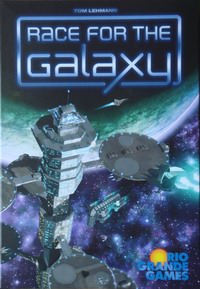 Release date: 2007
Release date: 2007
Mechanics: variable card powers, hand management, simultaneous action Players: 2 to 4 Playing time: 30 to 50 minutes Difficulty: easy Price: S$55 Despite some initial skepticism due to its "multi-player solitaire" game play, I grew to like Race for the Galaxy as it offered many card combos. I like the art on the cards too. When I first planned to buy the game, it was for the art — I still didn't like the game then. Game PlayRace for the Galaxy is a race for VPs. The player with the most VPs at the end of the game wins. The game ends when either when all the VPs are used up (12 * #players) or when a player builds his 12th card. VPs are gotten in three ways:
To consume goods, you must have worlds that can consume them. And to have goods, you need worlds that produce them. (Some worlds, called windfall worlds, come with an initial goods.) To build worlds, you need to pay for them. Cards act as money in the game. You get cards either through exploring, through a card's special power, or through selling a good. There are special cards that offer a variable number of VPs at end-game, depending on your other cards. They are expensive to build, but they can contribute many additional VPs too. They should definitely not be neglected. In each round, every player selects a possible action and places it face down until everyone has selected an action. There are 7 possible actions: explore, deep explore, develop, settle, trade-consume, consume 2xVP and produce. Only selected actions are carried out. The advantage of selecting an action is that you get its additional power. Also, your built cards can add on to these abilities. Once you get familiar with the game, you'll start to "leech" onto other people's action. OthersCommon mistakes made by newbies:
WeaknessRace for the Galaxy is very confusing for a new player, especially one who hasn't played Puerto Rico or San Juan. It also uses lots of icons, which is super-confusing the first few times, but is perfectly clear after that. ConclusionRace for the Galaxy is a short and good game. That's what ultimately won me over. [Aug 2008] I finally got this game despite wanting to buy it much earlier. It was OOP for several months. [Nov 2008] I got the expansion The Gathering Storm as well. [Jul 2009] I got the expansion Rebel vs Imperium. [Jul 2010] I got the expansion The Brink of War. |
| Razzia! |
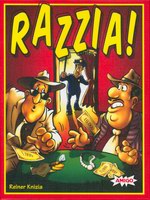 Release date: 2004
Release date: 2004
Mechanics: auction, set collection Players: 2 to 5 Playing time: 45 minutes Difficulty: medium Price: US$13 A simplified version of Ra (120 cards vs 180 tiles and no disasters). More portable as it is card based. |
| Robo Rally |
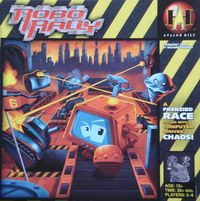 Release date: 1994
Release date: 1994
Mechanics: movement management, simultaneous action Players: 2 to 8 Playing time: 30 to 120 minutes Difficulty: easy Price: S$95 Robo Rally is a race game. The first robot to go through all the checkpoints (numbered in consecutive order) wins. It is not as easy as it sounds because the board is filled with danger — conveyor belts, pushers, laser beams and pit holes. Game PlayEach turn, everyone gets 9 movement cards, one less for each damage. These cards allow you to move and turn. Program 5 of them into the registers face down. This part of the game is often time consuming. To speed things up, there is a 30-second sand timer which the second slowest player is supposed to flip when he is done, giving the slowest player just 30 more seconds. When everyone is done, the cards are opened over 5 phases (each turn has 5 phases; never confuse the two!) In each phase, everyone reveals the first face down card and moves according to the card's priority order. Then the board elements react: conveyor belts move and pushers push. Then robots take damage: laser beams and a laser shooting from the front of each robot. Each robot can take 9 points of damage before it is destroyed, but when it takes the fifth damage, it locks the fifth register; the more damage, the more registers locked. You get fewer cards per turn and you don't remove movement cards for locked registers, so it's a double blow. To remove the damage, you need to power down for a turn, which you need to announce one turn in advance, or go to the repair sites, where one damage is removed at the end of a turn. There are also option cards that increase your robot's capabilities. You get them at the double wrench sites at the end of a turn. Powerful option cards give you more control over your robot, especially its movement. You can have as many option cards as you can get. If you get a lousy option card, don't worry, it can be "destroyed" instead of taking damage. The game is very flexible because there are 8 maps that can be combined in any order (2 maps on each side of a board, so not all maps can be combined). You can use any number of checkpoints and place them anywhere you like. The guide book comes with many sample courses, which is useful for new players. The game becomes pretty random once robots bump into one another; the pre-determined movements often become meaningless and sometimes even dangerous. A common mistake is to confuse between left and right. Don't be surprised; it happens in every game. OthersRobo Rally is a bit distinct from other games in that it can be played solo. WeaknessSince your movements are constrained by the cards that you draw, the luck factor can be quite high. It is reduced by using two cards to counter each other. With few players, there is little interaction and can become a solitaire race game. With many players, it becomes chaotic. Planning often becomes impossible. Conclusion[Oct 2006] Programming registers. A taste of machine language! |
| Scotland Yard |
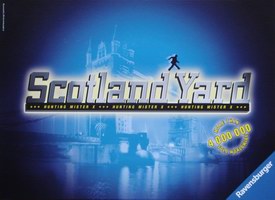 Release date: 1983
Release date: 1983
Mechanics: co-operative, hand management, deduction Players: 3 to 6 Playing time: 45 to 180 minutes Difficulty: medium Price: S$84 Track down Mr X in London. Game Play4 to 5 detectives attempt to track down Mr X. The detectives and Mr X are given a certain number of bus, taxi and underground tickets to allow them to move around the board. Mr X has a small number of black tickets (any mode of transport, including river) and double move tickets. The detectives are put openly on the board. Mr X is hidden, except for turns 3, 8, 13 and 18. On each turn, all the detectives move one step (they cannot pass) using their choice of transport and pass the ticket to Mr X. As time passes, Mr X has more options. If a detective is out of a particular ticket, he is not able to use that transport. Mr X then moves, keeping his move secret, but he must reveal his mode of transport. The detectives win if one of them hand on the same spot as Mr X. Mr X wins if he eludes the detectives for 24 turns. OthersThis is really a 2-player game. If the detectives don't co-operate and coordinate among themselves, Mr X will slip through them easily. Thus, only one person is needed to move all the detectives. It is only possible to use either four or five detectives. Mr X can elude three detectives with his eyes closed. Even four is cutting a bit close; Mr X has a huge advantage here. Five detectives should be able to catch Mr X most of the time. WeaknessThe game play is extremely variable. It can be very short if Mr X is apprehended early (within 8 turns), or very long if Mr X eludes for over 20 turns. There is only really one way to play this game. Just before Mr X reveals himself, the detectives must position themselves so that they can quickly narrow the net when Mr X appears. If they are able to do so, then they can use Mr X's mode of transport to deduce where he is and catch him. Mr X's position can only be tracked somewhat reliably for two to three turns after he appears, so the net must be pretty tight. Since Mr X reveals himself four times, the detectives are given four chances to catch him. Conclusion[Dec 2006] I like Scotland Yard for the deduction aspect, and will probably play it mostly as a 2-player game. I got the year 2000 edition. It is almost identical to the first edition, except that the first edition is more retro — it came out in 1983, what do you expect? I bought it at Borders with 15% off (so it's S$72). My LFGS (Local Friendly Game Shop) told me it's OOP, but I don't think so. |
| Super Cluedo Challenge |
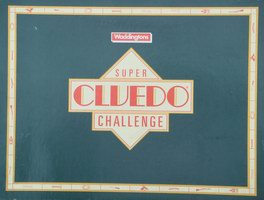 Release date: 1986
Release date: 1986
Mechanics: roll-n-move, deduction Players: 2 to 9 Playing time: 120 minutes (?) Difficulty: easy Price: OOP, US$10 to US$15 (used) There is a re-themed version called Passport to Murder that is very rare and very expensive. Starts at US$200. [Oct 2006] Haven't played yet. |
| Take 5! |
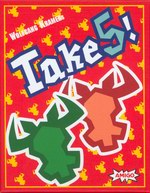 Release date: 1998
Release date: 1998
Mechanics: set forming Players: 2 to 6 Playing time: 20 to 25 minutes (?) Difficulty: easy Price: S$20 [Aug 2006] Played and liked Take 6!, but it wasn't available, so I got Take 5! instead. Take 5! can be used to play Take 6!, but up to 9 players instead of 10. In fact, I have yet to play a game of Take 5!! |
| Take 6! |
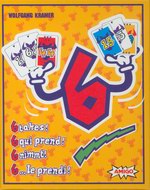 Release date: 1994
Release date: 1994
Mechanics: hand management, simultaneous action Players: 2 to 10 Playing time: 15 to 20 minutes Difficulty: easy Price: S$20 Take 6! is a card game, not a board game. It allows 2 to 10 players, so it's very versatile. The neat thing is it plays just as well with two. Once everyone is familiar with the game, each game takes only 10 to 15 minutes, so it's easy to squeeze in a game every now and then. Game PlayEveryone gets 10 cards. 4 cards are placed face up to form 4 separate stacks. Each player chooses a card and place it face down in front of him. When everyone is done, flip the cards. The smallest card goes first. Place it on the stack where (i) it is bigger than the top-of-stack, (ii) the difference between it and the top-of-stack is the smallest; it becomes the new top-of-stack. If the card is smaller than all the top-of-stack cards, the player has to replace it with one of the stacks; his choice. A stack can only hold five cards, so the player who puts the sixth card on a stack will get the whole stack and his card becomes the first card of that stack. The cards are put face down and are not reused. Do this until all the cards are put on the stacks, then repeat the cycle for the other 9 cards. On each card is one or more bull-heads. The objective of the game is to get as few bull-heads as possible. In the official rules, you play this game until one player has 66 bull-heads. The player with the fewest bull-head is the winner. However, you are free to play as many rounds as you like. OthersFor 2 players, I prefer to play with just 3 stacks to speed things up. Otherwise it takes a while to build a stack to 5 cards. There is a strategic variant where you deal cards numbered from 1 to n * 10 + 4, where n is the number of players. In this case, there are no missing numbers, so you can use that knowledge in your play. There's another variant that allows you to add cards to both ends of the stack, adding a lot of randomness. Find 11 chips per person, you can use the cards to play No Thanks. In fact, Take 6! can be used to play a number of games. Check out BGG. WeaknessThe luck factor is pretty high if you don't play the strategic version. That's because you have no idea whether a stack is safe or not. Although Take 6! supports up to 10 players, the configuration of the stacks can change very drastically within a turn for 5 players and more, so it becomes more luck than strategic. Conclusion[Dec 2006] Bought an extra copy to put in office. |
| Talisman |
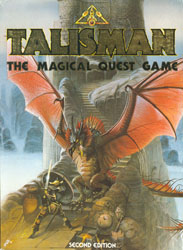 Release date: 1983
Release date: 1983
Mechanics: roll-n-move, variable card power Players: 2 to 6 Playing time: 180 to 240 minutes Difficulty: easy Price: OOP, US$60 (used) Talisman is a fantasy theme adventure game. Progress through three regions, defeat monsters, power up and reach the Crown of Command. [Jan 2006] Always have fond memories of it, even though I never played it much. Sad to say, but Talisman did not survive the test of time except for its nostalgia factor. The game is very random and unbalanced — that's why it was fun! And, a game took very long to finish. These days, anything beyond an hour is hardcore. I got these expansions as well:
Unable to get the Dragons expansion due to its rarity. I'm not willing to pay beyond US$300 (excluding shipping). |
| Talisman 4th edition |
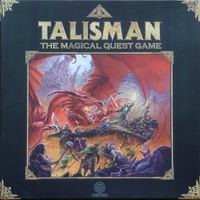 Release date: 2007
Release date: 2007
Mechanics: roll-n-move, variable card power Players: 2 to 6 Playing time: 180 to 240 minutes Difficulty: easy Price: S$93 Talisman 4th edition is a fantasy theme adventure game. Progress through three regions, defeat monsters, power up and reach the Crown of Command. It is pretty much a straight reprint of the second edition. |
| Talisman revised 4th edition |
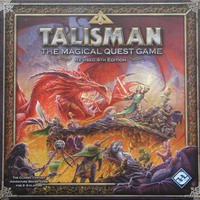 Release date: 2008
Release date: 2008
Mechanics: roll-n-move, variable card power Players: 2 to 6 Playing time: 180 to 240 minutes Difficulty: easy Price: S$75 I bought FFG's edition as it is a slight improvement over the BI edition. I am such a sucker when it comes to Talisman. I got these expansions as well:
|
| Ticket to Ride |
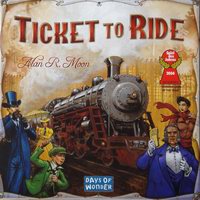 Release date: 2004
Release date: 2004
Mechanics: card drafting, hand management Players: 2 to 5 Playing time: 45 to 75 minutes Difficulty: easy Price: S$69 Game PlayTicket to Ride is a very simple game. The objective is to link up cities. At the start of the game, you're given 3 tickets (keep at least 2) and 4 train cards. The tickets indicate the cities you have to link — by any possible route — by the end of the game. If you do, you get the points on the tickets. If not, you subtract the points from your score. There are long and short routes. The train cards are for you to make sets of the same color, which you can then use to claim a route. There are 8 different colors, plus one set of wild cards that can substitute for any other colors. Each turn, you can do one of these three actions: (a) take 2 train cards, (b) claim a route, or (c) take 3 tickets (keep at least one). There is no limit to your hand size, so you can keep collecting train cards. There are always 5 opened cards on the table. You can draw from it or the closed deck. The only limitation is that if you take a wildcard from the opened cards, you may not take the second card. When the deck is empty, the discarded train cards are shuffled and reused. A route is of length 1 to 6, is one of the 8 colors or gray. Gray means it can be claimed using any colors, but it must still be a set of the same colors. You score points every time you claim a route; the longer the route, the higher the points. A route of length 3 scores just 4 points, but a route of length 6 scores 15 points. Most routes can be claimed just once, but there are double routes that can be claimed by another player in a 4-5 players game. You are given 45 trains to link up cities. To claim a route, you discard the train cards of the same color and put your trains on the route. When one player has 2 or less trains left, the game enters the last turn. When you finish your tickets, or are confident of doing so, you may take more tickets. The risk isn't very high because you only need to keep one ticket, and if you have connected a long route, you may need very little work to link up the new tickets. WeaknessTicket to Ride suffers from its simplicity. There is very limited strategy and variation in game play. There are only two standard game plays: (a) if you draw short tickets, ignore them and go for the long routes to use up your trains as fast as possible to force a short game. This penalizes other players going for long routes. (b) if you draw long tickets, after you make your connections, draw more tickets. Often, you need very little effort to finish the new tickets. Conclusion[Apr 2007] Finally got this after months of hesitation! I got the Ticket to Ride: USA 1910 expansion as well. This is what tipped my hand, even so, it took a few months for me to decide. I was afraid I would outgrow the game easily. It is a very simple game, after all. |
| Ticket to Ride: the Card Game |
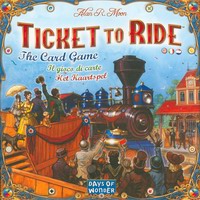 Release date: 2008
Release date: 2008
Mechanics: hand management Players: 2 to 4 Playing time: 30 minutes Difficulty: ? Price: ? Birthday gift from my colleagues for my 21(h) birthday! |
Misc
My brother has the following games:
- Bang!
- Carcassonne The Tower (expansion)
- Castle Keep
- Saint Petersburg
- Saboteur
- Sleeping Queens
- The Settlers of Catan
- The Seafarers of Catan (expansion)
- Zeus On The Loose